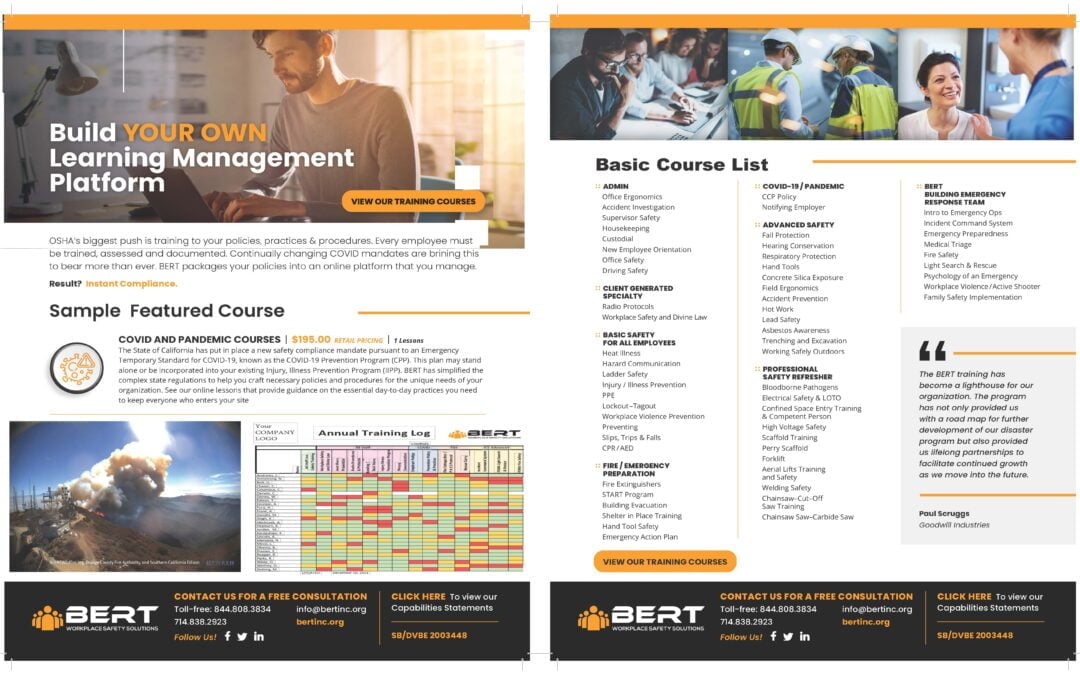Safety Training: You know your team needs it. You know it’s important. And with so many competing demands on everyone’s time it all seems daunting. Somehow to deliver safety training ends up at the bottom of day to day priorities. So what can you do to know which is right for you?
A good first start is to understand your options. There are more delivery systems available than ever before. So, here is a basic primer on three ways to provide safety training, including the benefits as well as drawbacks of each.
Online video classes.
With the ease and increase of electronic delivery systems video safety classes have exploded in number and popularity.
-
Benefits –
- Pre-recorded classes are low-priced and can be purchased individually or in bulk, especially if you have a large number of employees who need to be trained on a specific topic, such as fire safety, ladder use, safety hazards in the office, or lifting.
- There is a wide range and variety of video topics available.
- With a good online Learning Management System (LMS) you can easily log and keep track of who has taken the class. It offers record keeping made simple.
- People can take the class on their own anywhere, anytime from their desk top, lap top or other device. You can also invite or require groups of employees to log on and take the class at the same time.
- Recorded classes often end with quizzes, so you know that everyone has been assessed on basic content and whether they have passed or not. Those who have passed can be given a certificate of completion
-
Drawbacks –
- Video classes are a one size fits all approach that does not allow for questions and answers to meet individual or group needs.
- While some video content can be very engaging, some participants may have a short interest span and lose focus. Not everyone is inclined to learn without live interaction.
- If several people are assigned to take a video class, it’s tempting to cut corners and have colleagues share test questions and answers, which defeats the goal of real learning.
- While this option allows your organization to efficiently check boxes to satisfy safety training requirements, the person’s retention is often quickly perishable.
Live-online Classes.
Over the last two years the Pandemic has changed how we work and learn. Nearly all forms of education or instruction, including safety training, which once were taught in person where people met in classrooms, has transitioned to electric platforms like Zoom.
Benefits –
- While not as low priced as video options, this method can still be very cost effective, and offers a high-value impact.
- The greatest benefit here is having a live instructor who fosters interaction and discussion.
- An instructor can better observe or read the group to respond in the moment. It allows for questions and answers. It’s flexible. No two groups are exactly the same, even when covering the same material.
- Participants are more likely to be engaged with the instructor or with each other, especially when the class breaks out into small discussion topics.
- This option offers a hybrid safety training method by inserting short videos in between lecture and discussion. There is more variety in format so students are less likely to lose interest.
- As with video classes you can use an LMS program to log and maintain records of participation. This can aide in scheduled employee performance evaluations.
Drawbacks –
- Live online safety classes require a fixed day and time. So employees or participants must commit to the schedule. If they miss a class or session, the employer must decide on how to deliver a second chance or impose consequences. Some organizations contract for multiple sessions so their people can choose which session best meets their needs.
- This type of safety training works best if there is a supervisor or manager online as well as the instructor. If workers don’t feel they are being observed for participation or accountability, they may be less involved or may turn off their video cameras.
- Without some form of assessment it can be difficult to measure how well participants retained the content of the class. Course providers can offer separate access to online tests, or copies of tests to be administered by supervisors at the work site.
Live In-person Safety Training.
There is really no substitute for face to face instruction. The quality is unmatched when people meet physically together in the same place at the same time. That was the only method many of us grew up with and have been used to doing. There are still limited but valuable options available.
Benefits –
- One major benefit is when safety training topics involve practice or drills to get experience in working together for survival in case of a crisis. Most particularly, this type of safety training is best used in learning what to do in case of large-scale emergencies like wild-fires, earthquakes, floods, power-outages and civil unrest. It involves emergency management principles much like those FEMA uses with its Incident Command System (ICS) or like CERT classes provided by local police for residential neighborhoods to handle emergency response.
- After multiple hands-on instructional sessions, some In-person safety training may involve a full-scale emergency drill scenario attended by real local fire-fighters and fire trucks, along with other first-responders. Afterwards, participants receive input from safety experts on what went well and what could be done better.
- Most participants take away an unforgettable experience with knowledge they can apply at home with their families as well as in the workplace.
Drawbacks –
- In-person safety training is the most expensive option and requires a long-term commitment by employers for in-depth instruction of their employees. Moreover, it’s tough to schedule to meet everyone’s needs.
- Course topics available are limited. Most safety training providers and employers find it is not cost-effective to provide in-person training for short workshops on subjects like how to use a fire-extinguisher or ladder safety.
WHAT’S NEXT? BERT CAN HELP.
By now you probably have got a good idea of what would work best for you and your organization. That leads to the next step in finding specific courses, instructors, LMS tools, and of course, pricing to meet your budget. We at the BERT Team can offer you a plan custom designed to meet your needs. Call now or email us for a FREE, no obligation consultation and proposal.








